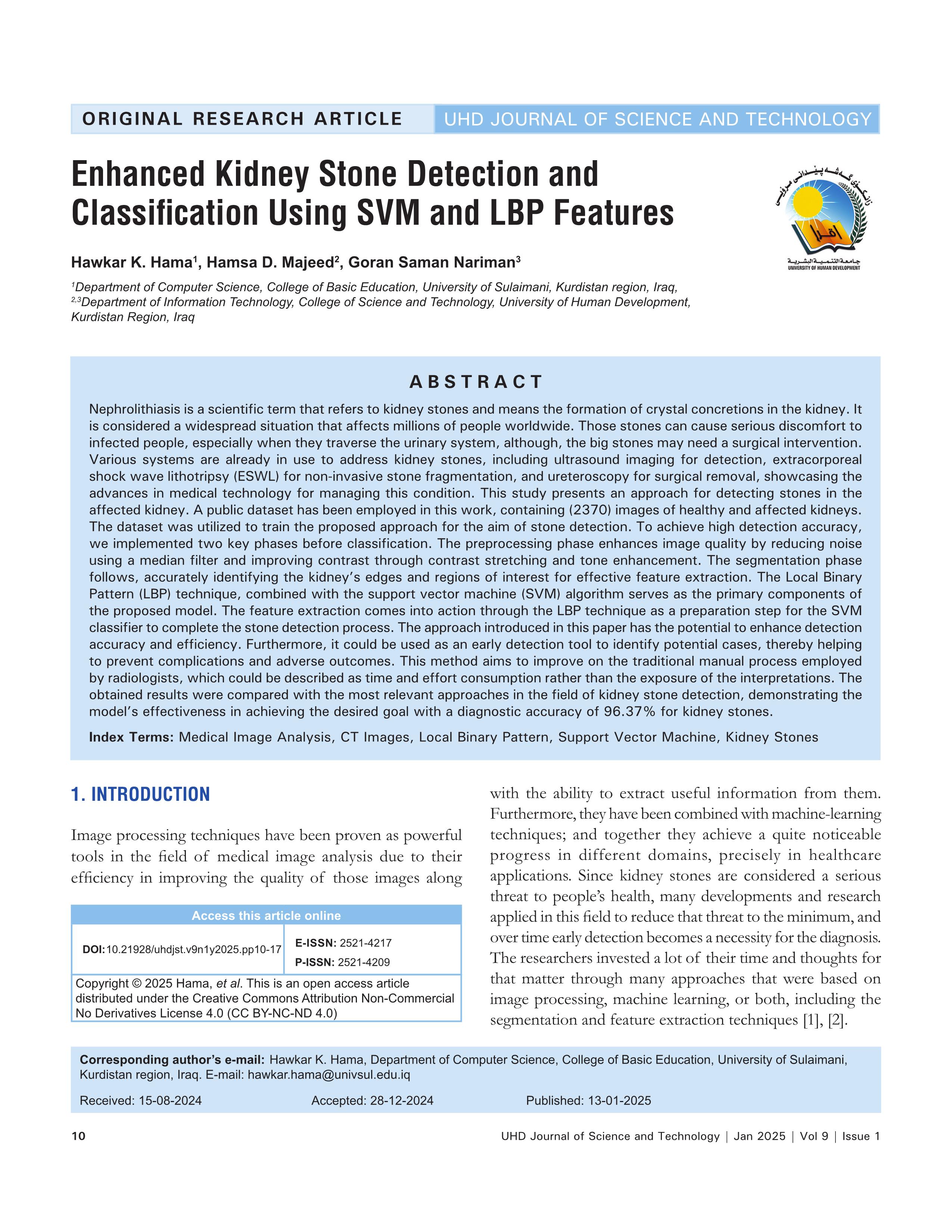Enhanced Kidney Stone Detection and Classification Using SVM and LBP Features
DOI:
https://doi.org/10.21928/uhdjst.v9n1y2025.pp10-17Keywords:
Medical Image Analysis, CT Images, Local Binary Pattern, Support Vector Machine, Kidney StonesAbstract
Nephrolithiasis is a scientific term that refers to kidney stones and means the formation of crystal concretions in the kidney. It is considered a widespread situation that affects millions of people worldwide. Those stones can cause serious discomfort to infected people, especially when they traverse the urinary system, although, the big stones may need a surgical intervention. Various systems are already in use to address kidney stones, including ultrasound imaging for detection, extracorporeal shock wave lithotripsy (ESWL) for non-invasive stone fragmentation, and ureteroscopy for surgical removal, showcasing the advances in medical technology for managing this condition. This study presents an approach for detecting stones in the affected kidney. A public dataset has been employed in this work, containing (2370) images of healthy and affected kidneys. The dataset was utilized to train the proposed approach for the aim of stone detection. To achieve high detection accuracy, we implemented two key phases before classification. The preprocessing phase enhances image quality by reducing noise using a median filter and improving contrast through contrast stretching and tone enhancement. The segmentation phase follows, accurately identifying the kidney’s edges and regions of interest for effective feature extraction. The Local Binary Pattern (LBP) technique, combined with the support vector machine (SVM) algorithm serves as the primary components of the proposed model. The feature extraction comes into action through the LBP technique as a preparation step for the SVM classifier to complete the stone detection process. The approach introduced in this paper has the potential to enhance detection accuracy and efficiency. Furthermore, it could be used as an early detection tool to identify potential cases, thereby helping to prevent complications and adverse outcomes. This method aims to improve on the traditional manual process employed by radiologists, which could be described as time and effort consumption rather than the exposure of the interpretations. The obtained results were compared with the most relevant approaches in the field of kidney stone detection, demonstrating the model’s effectiveness in achieving the desired goal with a diagnostic accuracy of 96.37% for kidney stones.
References
S. Singh, H. Singh, G. Bueno, O. Deniz, S. Singh, H. Monga and P. N. Hrisheekesha. “A review of image fusion: Methods, applications and performance metrics”. Digital Signal Processing, vol. 137, pp. 104020-104020, 2023.
Y. M. Y. Abdallah and T. Alqahtani. “Research in medical imaging using image processing techniques”. In: Medical Imaging-Principles and Applications. BoD-Books on Demand, Norderstedt, 2019.
M. Javaid, A. Haleem, R. P. Singh, R. Suman and S. Rab. “Significance of machine learning in healthcare: Features, pillars and applications”. International Journal of Intelligent Networks, vol. 3, pp. 58-73, 2022
A. Soni and A. Rai. “Kidney Stone Recognition and Extraction Using Directional Emboss and SVM from Computed Tomography Images”. Institute of Electrical and Electronics Engineers, United States, 2020.
V. Nazmdeh and S. S. Esmaili. “A review of methods for detection and segmentation of kidney stones from CT scan images using image processing method”. International Journal of Cybernetics and Cyber-Physical Systems, vol. 1, no. 2, p. 157, 2022.
R. Goel and A. Jain. “Improved detection of kidney stone in ultrasound images using segmentation techniques”. In: Advances in Data and Information Sciences. Springer Nature, Germany, pp. 623-641, 2020.
J. Verma, M. Nath, P. Tripathi and K. K. Saini. “Analysis and identification of kidney stone using Kth nearest neighbour (KNN) and support vector machine (SVM) classification techniques”. In: Pattern Recognition and Image Analysis. Vol. 27. Springer, Germany, pp. 574-580, 2017.
A. H. Ali. “Studying the kidney textural using statistical features and local binary pattern”. Journal of Al-Nahrain University Science, vol. 20, no. 4, pp. 64-76
A. Martinez, D. H. Trinh, J. El Beze, J. Hubert, P. Eschwege, V. Estrade, L. Aguilar, C. Daul and G. Ochoa. “Towards an Automated Classification Method for Ureteroscopic Kidney Stone Images using Ensemble Learning”. HAL (Le Centre pour la Communication Scientifique Directe), IEEE, United States, 2020.
G. Ochoa-Ruiz. “On the in vivo Recognition of Kidney Stones Using Machine Learning”. Cornell University, United States, 2022.
P. Chak, P. Navadiya, B. Parikh and K. C. Pathak. “Neural network and SVM based kidney stone based medical image classification”. In: Communications in Computer and Information Science. Springer, Germany, pp. 158-173, 2020.
K. Somasundaram, S. M. Animekalai and P. Sivakumar. “An Efficient Detection of Kidney Stone Based on HDVS Deep Learning Approach”. ICCAP, Pennsylvania, 2021.
S. Selvarani and P. Rajendran. “Detection of renal calculi in ultrasound image using meta-heuristic support vector machine”. Journal of Medical Systems, vol. 43, no. 9, p. 300, 2019.
I. Aksakalli, S. Kaçdioğlu and Y. S. Hanay. “Kidney X-ray images classification using machine learning and deep learning methods”. Balkan Journal of Electrical and Computer Engineering, vol. 9, pp. 144-151, 2021.
P. Sinha and P. Sinha. “Comparative study of chronic kidney disease prediction using KNN and SVM”. International Journal of Engineering Research, vol. V4, no. 12, 2015, p. 608.
H. D. Majeed and G. S. Nariman. “Construction of alphabetic character recognition systems: A review”. UHD Journal of Science and Technology, vol. 7, no. 1, pp. 32-42, 2023.
“CT Kidney Dataset: Normal-Cyst-Tumor and Stone”. Available from: https://www.kaggle.com/datasets/nazmul0087/ct-kidney-dataset-normal-cyst-tumor-and-stone [Last accessed on 2025 Jan 08].
T. Ojala, M. Pietikäinen and D. Harwood. “A comparative study of texture measures with classification based on featured distributions”. Pattern Recognition, vol. 29, no. 1, pp. 51-59, 1996.
V. N. Vapnik. “Statistical Learning Theory”. Wiley, Cop, New York, 1998.

Downloads
Published
How to Cite
Issue
Section
License
Copyright (c) 2025 Hawkar K. Hama, Hamsa D. Majeed, Goran Saman Nariman

This work is licensed under a Creative Commons Attribution-NonCommercial-NoDerivatives 4.0 International License.


